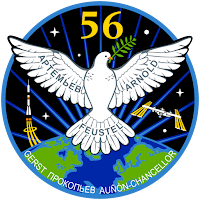ISS - Expedition 56 Mission patch.
Space Station Science Highlights: Week of June 11, 2018
June 15, 2018
Scientific work continued aboard the International Space Station this week, as crew members collected biological samples, observed crystal growth, tested grip force, and more.
International Space Station (ISS). Animation Credit: NASA
NASA astronaut Serena Auñón-Chancellor, Alexander Gerst of the European Space Agency (ESA), and Sergey Prokopyev of Roscosmos recently joined Expedition 56 and began pitching in on these and other science tasks.
Here are more details on this week’s scientific work aboard your orbiting laboratory:
Crystal close-ups
Advanced Colloids Experiment-Temperature-7 (ACE-T-7) investigates self-assembled colloids, which are complex three-dimensional structures made from small particles suspended within a fluid medium. These are vital to design of advanced optical materials and active devices.
Image above: NASA astronaut Ricky Arnold performs maintenance on the Advanced Colloids Experiment Module located inside the Light Microscopy Module, a modified commercial, highly flexible, state-of-the-art light imaging microscope facility that provides researchers with powerful diagnostic hardware and software in microgravity. Image Credit: NASA.
Activity on ACE-T-7 this week included mixing of Capillaries 1, 2 and 3 based on observed crystal formation. Science imaging of all three capillaries continues, as well as adjusting camera settings on Capillary 1 to optimize surface crystal images.
That feeling in your gut
Fecal samples were collected for JAXA’s Multi-Omics experiment and placed in the Minus Eighty-Degree Celsius Laboratory Freezer for ISS (MELFI). Crew also collected saliva samples for the investigation.
Multi-Omics evaluates how the space environment and prebiotics affect an astronauts’ immune function, combining data on changes in the gut microbial composition, metabolites profiles, and the immune system.
Get a grip
Image above: Astronaut Alexander Gerst of the European Space Agency conducts part of the GRIP investigation, which tests how spaceflight affects grip force and upper limb movements. Image Credit: NASA.
The European Space Agency’s GRIP investigation studies the effects of long-duration spaceflight and the forces of gravity and inertia on grip force and upper limb movements during manipulation of objects. Results may provide insight into potential hazards as astronauts move between different gravitational environments, as well as support design and control of human-computer interactions in challenging environments such as space. Information from the investigation also could be useful for rehabilitation of impaired upper limb control as a result of neurological diseases in patients on Earth.
This week, the crew completed the third of three GRIP operations in the supine position, or lying down facing up.
Blood, breath, and no tears
Image above: NASA astronaut Serena Auñón-Chancellor preparing to conduct air sampling for the Marrow investigation, a study of microgravity’s effect on bone marrow and the blood cells it produces. Image Credit: NASA.
Crew collected breath and blood samples for CSA’s Marrow investigation, which looks at the effect of microgravity on bone marrow. It is believed that microgravity has a negative effect on the bone marrow and the blood cells produced in bone marrow, similar to the effects of long-duration bed rest on Earth.
This week also included collection of blood samples for JAXA’s CFE and Medical Proteomics investigations, Vascular Echo, Functional Immune and Probiotics.
Space to Ground: Enhancing the View: 06/15/2018
Other work was done on these investigations: Atomization, Nanoracks/Barrios PCG, CEO, ASIM, Microbial Tracking 2, Plant Habitat, Area PADLES, Veggie/PONDS, HDEV, JEM Camera Robot, Vascular Echo, Functional Immune, Probiotics, and CAL.
Related links:
Advanced Colloids Experiment-Temperature-7 (ACE-T-7): https://www.nasa.gov/mission_pages/station/research/experiments/explorer/Investigation.html?#id=1708
JAXA’s Multi-Omics: https://www.nasa.gov/mission_pages/station/research/experiments/explorer/Investigation.html?#id=1689
Minus Eighty-Degree Celsius Laboratory Freezer for ISS (MELFI): https://www.nasa.gov/mission_pages/station/research/experiments/explorer/Facility.html?#id=56
European Space Agency’s GRIP: https://www.nasa.gov/mission_pages/station/research/experiments/explorer/Investigation.html?#id=1188
CSA’s Marrow: https://www.nasa.gov/mission_pages/station/research/experiments/explorer/Investigation.html?#id=1673
Vascular Echo: https://www.nasa.gov/mission_pages/station/research/experiments/explorer/Investigation.html?#id=1664
Functional Immune: https://www.nasa.gov/mission_pages/station/research/experiments/explorer/Investigation.html?#id=2011
Probiotics: https://www.nasa.gov/mission_pages/station/research/experiments/explorer/Investigation.html?#id=2047
Atomization: https://www.nasa.gov/mission_pages/station/research/experiments/explorer/Investigation.html?#id=282
Nanoracks/Barrios PCG: https://www.nasa.gov/mission_pages/station/research/experiments/explorer/Investigation.html?#id=7726
CEO: https://www.nasa.gov/mission_pages/station/research/experiments/explorer/Investigation.html?#id=84
ASIM: https://www.nasa.gov/mission_pages/station/research/experiments/explorer/Investigation.html?#id=1822
Microbial Tracking 2: https://www.nasa.gov/mission_pages/station/research/experiments/explorer/Investigation.html?#id=1663
Plant Habitat: https://www.nasa.gov/mission_pages/station/research/experiments/explorer/Investigation.html?#id=2032
Area PADLES: https://www.nasa.gov/mission_pages/station/research/experiments/explorer/Investigation.html?#id=877
Veggie/PONDS: https://www.nasa.gov/mission_pages/station/research/experiments/explorer/Investigation.html?#id=7581
HDEV: https://www.nasa.gov/mission_pages/station/research/experiments/explorer/Investigation.html?#id=892
JEM Camera Robot: https://www.nasa.gov/mission_pages/station/research/experiments/explorer/Investigation.html?#id=7516
CAL: https://www.nasa.gov/mission_pages/station/research/experiments/explorer/Facility.html?#id=7396
Spot the Station: https://spotthestation.nasa.gov/
Expedition 56: https://www.nasa.gov/mission_pages/station/expeditions/expedition56/index.html
Space Station Research and Technology: https://www.nasa.gov/mission_pages/station/research/index.html
International Space Station (ISS): https://www.nasa.gov/mission_pages/station/main/index.html
Animation (mentioned), Images (mentioned), Video, Text, Credits: NASA/Michael Johnson/John Love, Lead Increment Scientist (Acting) Expeditions 55 & 56.
Best regards, Orbiter.ch





